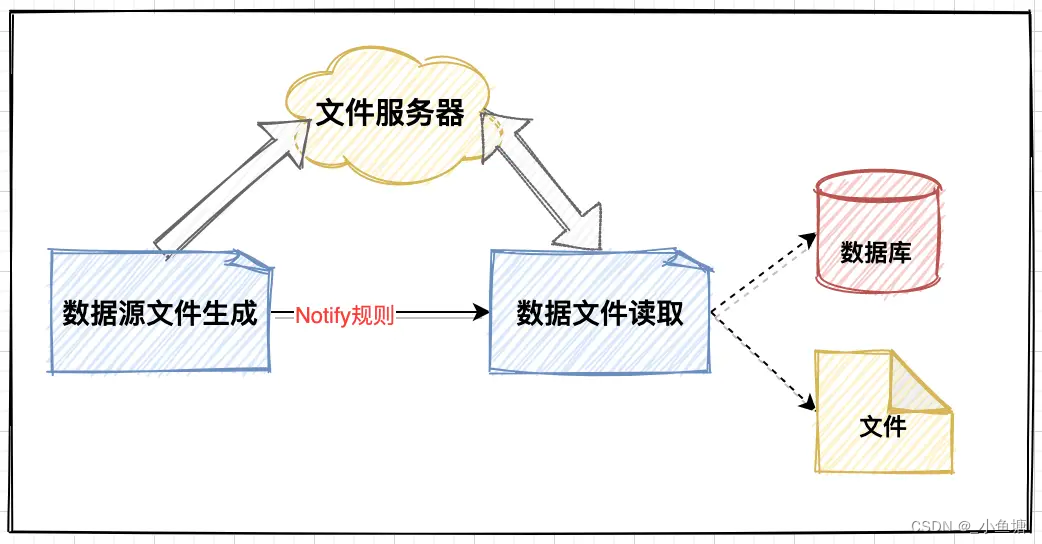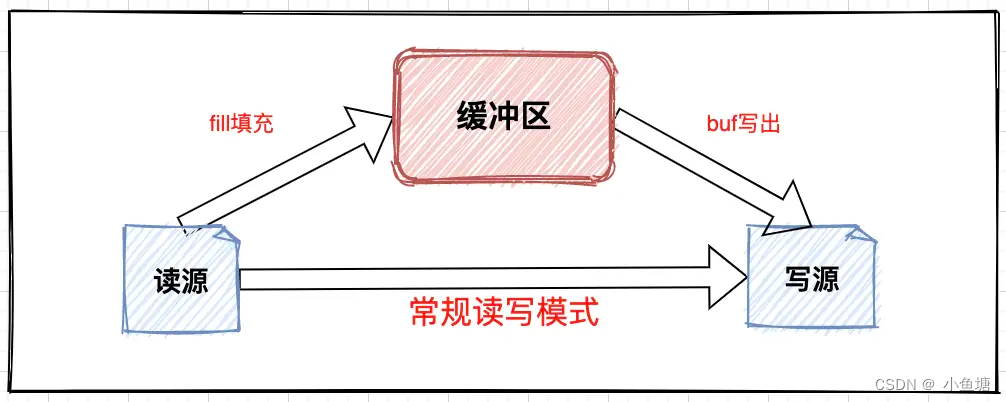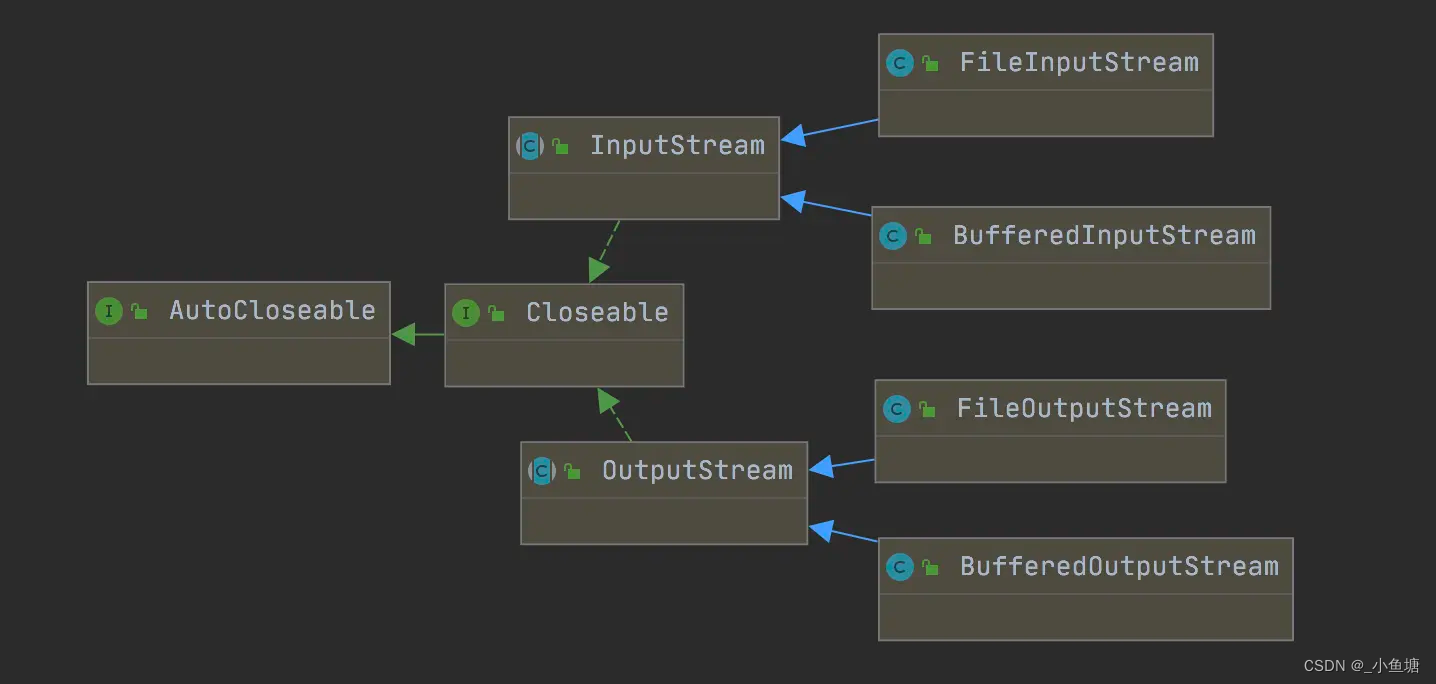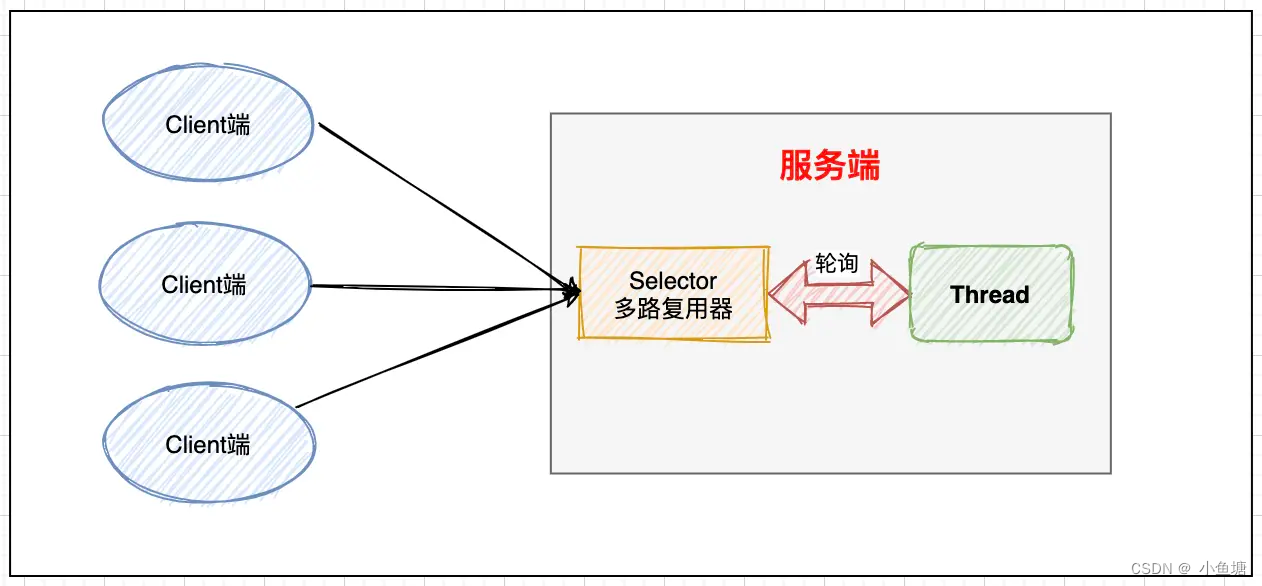JAVA常用工具-文件操作相关IO

IO技术在JDK中算是极其复杂的模块,文件管理都依赖IO技术,而且都是编程的难点,想要整体理解IO流,先从Linux操作系统开始,
Linux空间隔离
Linux使用是区分用户的,这个是基础常识,其底层也区分用户和内核两个模块:
- User space:用户空间
- Kernel space:内核空间
用户空间本身无法直接向系统发布调度指令,必须通过内核,对于内核中数据的操作,也是需要先拷贝到用户空间,这种隔离机制可以有效的保护系统的安全性和稳定性
IO模型分析
当应用端发起IO操作的请求时,请求沿着链路上的各个节点流转,有两个核心概念:
- 节点交互模式:同步与异步;
- IO数据操作:阻塞与非阻塞;
三、File文件类
1、基础描述
File类作为文件和目录路径名的抽象表示,用来获取磁盘文件的相关元数据信息,例如:文件名称、大小、修改时间、权限判断等
public class File01 {public static void main(String[] args) throws Exception {// 1、读取指定文件File speFile = new File(IoParam.BASE_PATH+"fileio-03.text") ;if (!speFile.exists()){boolean creFlag = speFile.createNewFile() ;System.out.println("创建:"+speFile.getName()+"; 结果:"+creFlag);}// 2、读取指定位置File dirFile = new File(IoParam.BASE_PATH) ;// 判断是否目录boolean dirFlag = dirFile.isDirectory() ;if (dirFlag){File[] dirFiles = dirFile.listFiles() ;printFileArr(dirFiles);}// 3、删除指定文件if (speFile.exists()){boolean delFlag = speFile.delete() ;System.out.println("删除:"+speFile.getName()+"; 结果:"+delFlag);}}private static void printFileArr (File[] fileArr){if (fileArr != null && fileArr.length>0){for (File file : fileArr) {printFileInfo(file) ;}}}private static void printFileInfo (File file) {System.out.println("名称:"+file.getName());System.out.println("长度:"+file.length());System.out.println("路径:"+file.getPath());System.out.println("文件判断:"+file.isFile());System.out.println("目录判断:"+file.isDirectory());System.out.println("最后修改:"+new Date(file.lastModified()));System.out.println();}
}2、文件业务场景
在常规的文件流任务中,会涉及【文件、流、数据】三种基本形式的转换:

任何节点都无法适配所有文件处理策略,比如类型与编码,面对复杂场景下的问题,规则约束是常用的解决策略,即在约定规则之内的事情才处理。
四、基础流模式
1、整体概述
基本编码逻辑:源文件->输入流->逻辑处理->输出流->目标文件;

基础API
-
字节流:InputStream输入、OutputStream输出;数据传输的基本单位是字节;
- read():输入流中读取数据的下一个字节;
- read(byte b[]):读数据缓存到字节数组;
- write(int b):指定字节写入输出流;
- write(byte b[]):数组字节写入输出流;
-
字符流:Reader读取、Writer写出;数据传输的基本单位是字符;
- read():读取一个单字符;
- read(char cbuf[]):读取到字符数组;
- write(int c):写一个指定字符;
- write(char cbuf[]):写一个字符数组;
缓冲模式

在BufferedInputStream、BufferedReader类中是对缓冲逻辑的具体实现
2、字节流
字节流应用场景:数据是文件本身,例如图片,视频,音频等。

基础api操作实例:
public class IoByte01 {public static void main(String[] args) throws Exception {// 源文件 目标文件File source = new File(IoParam.BASE_PATH+"fileio-01.png") ;File target = new File(IoParam.BASE_PATH+"copy-"+source.getName()) ;// 输入流 输出流InputStream inStream = new FileInputStream(source) ;OutputStream outStream = new FileOutputStream(target) ;// 读入 写出byte[] byteArr = new byte[1024];int readSign ;while ((readSign=inStream.read(byteArr)) != -1){outStream.write(byteArr);}// 关闭输入、输出流outStream.close();inStream.close();}
}public class IoByte02 {public static void main(String[] args) throws Exception {// 源文件 目标文件File source = new File(IoParam.BASE_PATH+"fileio-02.png") ;File target = new File(IoParam.BASE_PATH+"backup-"+source.getName()) ;// 缓冲:输入流 输出流InputStream bufInStream = new BufferedInputStream(new FileInputStream(source));OutputStream bufOutStream = new BufferedOutputStream(new FileOutputStream(target));// 读入 写出int readSign ;while ((readSign=bufInStream.read()) != -1){bufOutStream.write(readSign);}// 关闭输入、输出流bufOutStream.close();bufInStream.close();}
}3、字符流
字符流应用场景:文件作为数据的载体,例如Excel、CSV、TXT等。

基本api操作实例
public class IoChar01 {public static void main(String[] args) throws Exception {// 读文本 写文本File readerFile = new File(IoParam.BASE_PATH+"io-text.txt") ;File writerFile = new File(IoParam.BASE_PATH+"copy-"+readerFile.getName()) ;// 字符输入输出流Reader reader = new FileReader(readerFile) ;Writer writer = new FileWriter(writerFile) ;// 字符读入和写出int readSign ;while ((readSign = reader.read()) != -1){writer.write(readSign);}writer.flush();// 关闭流writer.close();reader.close();}
}public class IoChar02 {public static void main(String[] args) throws Exception {// 读文本 写文本File readerFile = new File(IoParam.BASE_PATH+"io-text.txt") ;File writerFile = new File(IoParam.BASE_PATH+"line-"+readerFile.getName()) ;// 缓冲字符输入输出流BufferedReader bufReader = new BufferedReader(new FileReader(readerFile)) ;BufferedWriter bufWriter = new BufferedWriter(new FileWriter(writerFile)) ;// 字符读入和写出String line;while ((line = bufReader.readLine()) != null){bufWriter.write(line);bufWriter.newLine();}bufWriter.flush();// 关闭流bufWriter.close();bufReader.close();}
}4、编码解码
- 编码:字符转换为字节;
- 解码:字节转换为字符;
public class EnDeCode {public static void main(String[] args) throws Exception {String var = "IO流" ;// 编码byte[] enVar = var.getBytes(StandardCharsets.UTF_8) ;for (byte encode:enVar){System.out.println(encode);}// 解码String deVar = new String(enVar,StandardCharsets.UTF_8) ;System.out.println(deVar);// 乱码String messyVar = new String(enVar,StandardCharsets.ISO_8859_1) ;System.out.println(messyVar);}
}5、序列化
- 序列化:对象转换为流的过程;
- 反序列化:流转换为对象的过程;
public class SerEntity implements Serializable {private Integer id ;private String name ;
}
public class Seriali01 {public static void main(String[] args) throws Exception {// 序列化对象OutputStream outStream = new FileOutputStream("SerEntity.txt") ;ObjectOutputStream objOutStream = new ObjectOutputStream(outStream);objOutStream.writeObject(new SerEntity(1,"Cicada"));objOutStream.close();// 反序列化对象InputStream inStream = new FileInputStream("SerEntity.txt");ObjectInputStream objInStream = new ObjectInputStream(inStream) ;SerEntity serEntity = (SerEntity) objInStream.readObject();System.out.println(serEntity);inStream.close();}
}五、NIO模式
1、基础概念
NIO即(NonBlockingIO),面向数据块的处理机制,同步非阻塞模型,服务端的单个线程可以处理多个客户端请求,对IO流的处理速度有极高的提升,三大核心组件:
- Buffer(缓冲区):底层维护数组存储数据;
- Channel(通道):支持读写双向操作;
- Selector(选择器):提供Channel多注册和轮询能力;
public class IoNew01 {public static void main(String[] args) throws Exception {// 源文件 目标文件File source = new File(IoParam.BASE_PATH+"fileio-02.png") ;File target = new File(IoParam.BASE_PATH+"channel-"+source.getName()) ;// 输入字节流通道FileInputStream inStream = new FileInputStream(source);FileChannel inChannel = inStream.getChannel();// 输出字节流通道FileOutputStream outStream = new FileOutputStream(target);FileChannel outChannel = outStream.getChannel();// 直接通道复制// outChannel.transferFrom(inChannel, 0, inChannel.size());// 缓冲区读写机制ByteBuffer buffer = ByteBuffer.allocateDirect(1024);while (true) {// 读取通道中数据到缓冲区int in = inChannel.read(buffer);if (in == -1) {break;}// 读写切换buffer.flip();// 写出缓冲区数据outChannel.write(buffer);// 清空缓冲区buffer.clear();}outChannel.close();inChannel.close();}
}2、网络通信
服务端的单线程可以处理多个客户端请求,通过轮询多路复用器查看是否有IO请求,这样一来,服务端的并发能力得到极大的提升,并且显著降低了资源的消耗

服务端模拟
public class SecServer {public static void main(String[] args) {try {//启动服务开启监听ServerSocketChannel socketChannel = ServerSocketChannel.open();socketChannel.socket().bind(new InetSocketAddress("127.0.0.1", 8089));// 设置非阻塞,接受客户端socketChannel.configureBlocking(false);// 打开多路复用器Selector selector = Selector.open();// 服务端Socket注册到多路复用器,指定兴趣事件socketChannel.register(selector, SelectionKey.OP_ACCEPT);// 多路复用器轮询ByteBuffer buffer = ByteBuffer.allocateDirect(1024);while (selector.select() > 0){Set<SelectionKey> selectionKeys = selector.selectedKeys();Iterator<SelectionKey> selectionKeyIter = selectionKeys.iterator();while (selectionKeyIter.hasNext()){SelectionKey selectionKey = selectionKeyIter.next() ;selectionKeyIter.remove();if(selectionKey.isAcceptable()) {// 接受新的连接SocketChannel client = socketChannel.accept();// 设置读非阻塞client.configureBlocking(false);// 注册到多路复用器client.register(selector, SelectionKey.OP_READ);} else if (selectionKey.isReadable()) {// 通道可读SocketChannel client = (SocketChannel) selectionKey.channel();int len = client.read(buffer);if (len > 0){buffer.flip();byte[] readArr = new byte[buffer.limit()];buffer.get(readArr);System.out.println(client.socket().getPort() + "端口数据:" + new String(readArr));buffer.clear();}}}}} catch (Exception e) {e.printStackTrace();}}
}客户端模拟
public class SecClient {public static void main(String[] args) {try {// 连接服务端SocketChannel socketChannel = SocketChannel.open();socketChannel.connect(new InetSocketAddress("127.0.0.1", 8089));ByteBuffer writeBuffer = ByteBuffer.allocate(1024);String conVar = "[hello-8089]";writeBuffer.put(conVar.getBytes());writeBuffer.flip();// 每隔5S发送一次数据while (true) {Thread.sleep(5000);writeBuffer.rewind();socketChannel.write(writeBuffer);writeBuffer.clear();}} catch (Exception e) {e.printStackTrace();}}
}